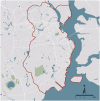The Neighborhood Food Environment and the Onset of Child-Hood Obesity: A Retrospective Time-Trend Study in a Mid-sized City in China
- PMID: 34381750
- PMCID: PMC8350029
- DOI: 10.3389/fpubh.2021.688767
The Neighborhood Food Environment and the Onset of Child-Hood Obesity: A Retrospective Time-Trend Study in a Mid-sized City in China
Abstract
Nowadays, obesity and its associated chronic diseases have become a steadily growing public health problem, spreading from the older to younger age groups. Studies have contended that the built environment, particularly the food environment and walkability, may contribute to the prevalence of childhood obesity. In Asian countries which are characterized by rapid urbanization, high population density and oriental diets, little is known about how such urban built environment affects the onset of childhood obesity. This study juxtaposes the effect of food environment, walkability, and outdoor activity spaces at the neighborhood level upon childhood body weight in a mid-sized city in China. This observational study utilizes a retrospective time-trend study design to examine the associations between neighborhood built environment and children's body weight in Zhanjiang City, a mid-sized city in Guangdong Province, China. Robust multiple linear and logistic regression models were used to estimate associations between the built environments and child BMI and weight status (i.e., overweight/obesity and obesity only). This study finds that: (1) Western-style fast food and Chinese-style fast food have divergent impacts on childhood body weight. At neighborhood level, while increased exposure to Western-style fast food may increase child BMI and the risk of overweight and obesity, increased exposure to Chinese-style fast food, on the contrary, may reduce child BMI and the risk of overweight and obesity, indicating a positive health impact of Chinese-style fast food. (2) However, the positive health impacts brought about by Chinese-style fast food, walkable environments and accessible traditional fruit/vegetable markets have gradually disappeared in recent years. This study is among the first to simultaneously consider the divergent and changing impact of food environment upon childhood body weight in urban China. The findings provide important implications for healthy city design and the management of food retail industry in addressing the obesity epidemic in younger generations living in Asian cities. As prominent differences exist in food culture between Asian and Western cities, more attention should be paid to healthy food environment in future studies and related urban planning strategies formulation.
Keywords: China; built environment; childhood obesity; food environment; neighborhood.
Copyright © 2021 Zhou, Li and Liu.
Conflict of interest statement
The authors declare that the research was conducted in the absence of any commercial or financial relationships that could be construed as a potential conflict of interest.
Figures
Similar articles
-
Fast food consumption and its associations with obesity and hypertension among children: results from the baseline data of the Childhood Obesity Study in China Mega-cities.BMC Public Health. 2017 Dec 6;17(1):933. doi: 10.1186/s12889-017-4952-x. BMC Public Health. 2017. PMID: 29212483 Free PMC article.
-
Effects of school neighborhood food environments on childhood obesity at multiple scales: a longitudinal kindergarten cohort study in the USA.BMC Med. 2019 May 22;17(1):99. doi: 10.1186/s12916-019-1329-2. BMC Med. 2019. PMID: 31117993 Free PMC article.
-
The effectiveness of web-based programs on the reduction of childhood obesity in school-aged children: A systematic review.JBI Libr Syst Rev. 2012;10(42 Suppl):1-14. doi: 10.11124/jbisrir-2012-248. JBI Libr Syst Rev. 2012. PMID: 27820152
-
Associations of built environment and children's physical activity: a narrative review.Rev Environ Health. 2017 Dec 20;32(4):315-331. doi: 10.1515/reveh-2016-0046. Rev Environ Health. 2017. PMID: 28809754 Review.
-
Contributions of built environment to childhood obesity.Mt Sinai J Med. 2011 Jan-Feb;78(1):49-57. doi: 10.1002/msj.20235. Mt Sinai J Med. 2011. PMID: 21259262 Review.
Cited by
-
Roles of gut microbiota and metabolites in overweight and obesity of children.Front Endocrinol (Lausanne). 2022 Sep 8;13:994930. doi: 10.3389/fendo.2022.994930. eCollection 2022. Front Endocrinol (Lausanne). 2022. PMID: 36157438 Free PMC article. Review.
-
Characteristics of stachyose-induced effects on gut microbiota and microbial metabolites in vitro associated with obesity in children.Front Nutr. 2024 Aug 7;11:1411374. doi: 10.3389/fnut.2024.1411374. eCollection 2024. Front Nutr. 2024. PMID: 39171106 Free PMC article.
-
Food Acquisition during the COVID-19 Lockdown and Its Associations with the Physical-Digital Integrated Community Food Environment: A Case Study of Nanjing, China.Int J Environ Res Public Health. 2022 Jun 29;19(13):7993. doi: 10.3390/ijerph19137993. Int J Environ Res Public Health. 2022. PMID: 35805653 Free PMC article.
-
Association between built environments and weight status: evidence from longitudinal data of 9589 Australian children.Int J Obes (Lond). 2022 Aug;46(8):1534-1543. doi: 10.1038/s41366-022-01148-6. Epub 2022 May 30. Int J Obes (Lond). 2022. PMID: 35637263 Free PMC article.
-
Neighborhood Food Environment and Children's BMI: A New Framework with Structural Equation Modeling.Nutrients. 2022 Nov 3;14(21):4631. doi: 10.3390/nu14214631. Nutrients. 2022. PMID: 36364893 Free PMC article.
References
-
- World Health Organization . Obesity: Preventing and Managing the Global Epidemic. World Health Organization (2000). Available online at: http://www.who.int/entity/nutrition/publications/obesity/WHO_TRS_894/en/... (accessed April 15, 2020). - PubMed
Publication types
MeSH terms
LinkOut - more resources
Full Text Sources
Medical
Research Materials


